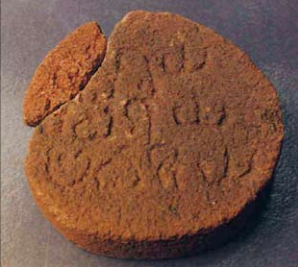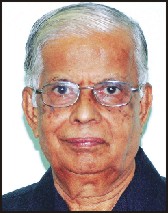
Centre of Jaina Studies Newsletter: SOAS - University of London
In 2002 a chance discovery of a circular laterite tablet was made at Parkaḷa, a place close to Maṇipāl on the Kārkaḷa-Uḍupi Road. The local youth organization took up the work of cleaning both sides of the main road (of its debris and bushes) in front of the Parkaḷa High School. While doing so they had totally destroyed a historic site not knowing its importance. On getting the information my friend Mr. Śrīdhara Bhaṭ (a high school teacher) went to Parkaḷa for making enquires about the work. He was shown a circular laterite piece found in the debris. Not knowing anything about it he took the find to Dr. B. Śivatārak who thought that the material was clay and he noticed Brāhmī letters. Finally the tablet reached my hands for examination.
I was surprised to see that in fact the circular tablet had been cut out of laterite stone and not made of clay. The 'tablet' was probably a capstone for covering the mouth of an earthen pot. On enquiry with the local youth organization which, unknowingly, had spoiled a burial site cut north-south out of a laterite surface of the ground, it came to light that the place where the tablet was found contained three pots which were completely damaged when opened and that the partially damaged tablet had been thrown near a tree. The description given by the Head of the youth organization clearly indicated that the spot contained three small holes at equidistance that contained small pots. This led me to conclude that the site had been a burial ground containing three funerary urns but was now destroyed beyond recovery. What could have been one of the greatest finds of Uḍupi was thus totally spoiled by the enthusiastic youth group. This circular laterite cut tablet is perhaps the first of its kind in South India (nay entire India) to be reported.[1]
The tablet has become an object of utmost importance from several points of view. Firstly, this is the one and only inscription in Brāhmī characters so far found in the coastal districts of Dakṣiṇa Kannaḍa and Uḍupi (Karṇāṭaka). Secondly, prior to this find, the inscription of Āḷuvarasa I from Vaḍḍarase assigned to the middle of the 7th century CE was considered as the earliest inscription of these two districts.[2] Thirdly, regarding the history of Jainism, this tablet is the earliest and the most ancient source from this region.
The tablet contains three lines of text in Brāhmī script:
- (yā)panīya
- yāpanīya
- avanīya [||*]

Avanīya is actually another form of yāpanīya.[3] I determined that the characters belonged to the period of the early Kadambas of Banavāsi (c. 325-540 CE), and for a final confirmation took the tablet to Dr. K.V. Ramesh, the famous epigraphist and scholar of the country, who expressed his consensus with me and opined that the script belongs to the 5th century CE. Of the early Kadamba records, the Halasi plates of Mṛgeśavarma (r. c. 455-480, 8th regnal year) and Ravivarma (r. c. 485-519), and the Devagiri plates of Prince Devavarma (middle of 5th century?) mention the Yāpanīyas.[4]
The text of the tablet has no details. But the term 'yāpanīya', mentioned thrice, is itself very important with respect to the history of Jainism in this region and the Yāpanīya sect of Jainism in particular. The Yāpanīyas emerged as a Jaina sect around the 2nd century CE in Karṇāṭaka.[5] They provided the much-needed hospitable homogeneity to the religion at that time and acted as a conduit between the Digambara and Śvetāmbara sects. More than that, perhaps, it was the Yāpanīya sect that was responsible for the growth and spread of Jainism in Karṇāṭaka through its policy of catholicity, adjustability, adoptability and better understanding with the dominant Hindu (precisely the Brahmanical) religion while uniting in a common cause against the strong Buddhist influence in Karṇāṭaka. Although it had entered later, Buddhism had made strong attempts to subjugate both these religions.[6] A rejuvenating force was necessary for uplifting both sections. The Yāpanīyas took the lead in this regard, which paid rich dividends but strangely was not recognized by the other Jaina sects.[7]
Movement of Ascetics
The Parkaḷa tablet indicates very clearly the movement of the ascetics of the Yāpanīya order in the southern part of coastal Karṇāṭaka. It is unusual in this region to find a burial site containing three small holes large enough to keep an earthen pot in each of them, and this suggests that it was a post-cremation burial of three ascetics. But, the cause, nature and actual place of their death are not known. It can be conjectured, that the region in and around Uḍupi was populated by an immigrant Jaina community, particularly with Yāpanīya leanings, and this prompted the three ascetics to perform the vow of sallekhanā to end their life (if not, some other reason must have caused the death of all the three together). After performing this post-cremation burial some kind of memorial must have been built over it, which in the course of time decayed.
The Term Avanīya
The tablet lists 'yāpanīya' twice and 'avanīya' once. Yāpanīya was very clear, but 'avanīya' puzzled me. I felt the term 'avanīya' was linguistically related to Kannaḍa and tried to equate it with 'yāpanīya'. But immediately the question arose as to why the term 'avanīya' was used where 'yāpanīya' could have been repeated in the third line also. This made me turn my attention towards the ancient Brāhmī inscriptions found in a good number of caves and rock beds in central and southern Tamiḷ Nāḍu[8] wherein I got the clue that 'avanīya' refers to the Yāpanīya. Jainas from Tamiḷ Nāḍu also were here (in Coastal Karṇāṭaka) probably on different professional grounds, which would explain the presence of Tamil Jaina ascetics who might have been well versed in Kannaḍa and other languages also. This view is supported on the basis of copious references found in the Sangam literature regarding the relations between the ancient Tamiḷ Nāḍu and the southern part of coastal Karṇāṭaka.[9] In this respect, the newly discovered tablet with a Brāhmī inscription from Parkaḷa is very important, for it happens to be the earliest epigraphical evidence for the 'Yāpanīyas' in Karṇāṭaka and for providing a clue to probe into the history of Jainism in this region prior to the 5th century CE
Scholars such as Manjeshwara Govinda Pai,[10] B.A.
Saletore,[11] K.V. Ramesh[12] and P. Gururaja Bhat[13] have earlier tried to assess the antiquity of Jainism in the southern part of Coastal Karṇāṭaka. Though expressed differently, their conclusions commonly indicate that Jainism entered this region around 12th-13th century CE.
The Halmiḍi inscription[14] of Kadamba Kakusthvarma [Kākutsthavarman] is the earliest Kannaḍa inscription on stone (c. 425 CE).[15] Arakella, a subordinate king-officer of the Āḷupas of coastal Karṇāṭaka, is mentioned in this record. The Kellas were the earliest Jaina ruling family in coastal Karṇāṭaka.[16] According to K.V. Ramesh, the Parkaḷa tablet belongs to c. 5th century CE (based on my discussion with him in this regard). In my opinion, the Parkaḷa tablet belongs to the time of Kadamba Kakusthvarma (c. 405-430 CE),[17] maybe a little earlier than the Halmiḍi record. Hence the tablet becomes the earliest record referring to Jainism in the southern part of coastal Karṇāṭaka (Tuḷu Nāḍu).
I am happy to state that my hypothesis, made on the basis of the Halmiḍi inscription, that Jainism had entered Tuḷu Nāḍu well before the 5th century CE,[18] seems to be supported by the 'Parkaḷa Brāhmī tablet'.[19]
P. N. Narasimha Murthy, retired principal of MGM College, Udupi, obtained his PhD from Mysore University on the basis of his thesis Jainism on the Kanara Coast. He has written several books on the history of Jainism in coastal Karnataka. His present projects include 'Sources for the Study of the Socio-economic History of the ALUPAS', 'Sources for the History of Dakshina Kannada', and 'Inscriptions of the Minor Dynasties of Coastal Karnataka'.
The tablet is now preserved in the museum of the Rāṣṭrakavi Gōvinda Pai Research Centre, M.G.M. College, Uḍupi
K.V. Ramesh: A History South Kanara: From the Earliest Times to the Fall of Vijayanagara. Dharwad: Karnatak University, 1970, p. 43. K.V. Ramesh & M.J. Sharma: Tuḷunāḍina Śāsanagaḷu. Vol. I, No. 1. Mysore: Geeta Book House, 1978 (On Behalf of Rāṣṭrakavi Gōvinda Pai Smāraka Samśodhana Kendra, Uḍupi).
According to Hampana Nagarajaiah apulīya and avulīya are Kannaḍa terms used differently but they also mean the same, yāpanīya.
B.R. Gopal: Corpus of Kadamba Inscriptions. Vol. I. Sirsi: Kadamba Institute of Cultural Studies, 1985, Nos. 13, 24 & 38.
P.N. Narasimha Murthy: "Advent of Jainism in Tulunadu in the Light of Recent Findings." Rishabh Saurabh: A Collection of Papers on Jaina Heritage of Karnataka. Eds. S.P. Narang, S.H. Paras Das Jain, T.A.V. Murthy, Bachchan Kumar & Aruna Anand. New Delhi: Rishabhdev Foundation, 1994, p. 14.
Iravatham Mahadevan, in Rishabh Saurabh, pp. 131-133. There is a reference to 'kantiyar' in Brāhmī Jaina inscriptions from Tamiḷ Nāḍu. The term 'kanti' (a Kannaḍa word) refers to a Jaina nun and the term 'kantiyar' may refer respectfully to a Jaina nun or to a group of nuns. This made me refer 'avanīya' to a Brāhmī source of Tamiḷ Nāḍu. Here, I am told, 'avanīya' is used for 'yāpanīya'
Heranje Krishna Bhat Bhat & Muralidhara Upadhyaya (Eds.): Gōvinda Pai Samśodhana Samputa (A Collection of Articles of Govinda Pai), Uḍupi: Rāṣṭrakavi Gōvinda Pai Smāraka Samśodhana Kendra, 1995, pp. 737-57.
Saletore
B. A. Saletore: Ancient Karṇāṭaka. Vol. I. History of Tuluva. Poona: Oriental Agency, 1936; Medieval Jainism. Bombay: Karnataka Publishing House, 1938.
Mysore Archaeological Reports 1936, pp. 72 ff. & plate; Prabuddha Karṇāṭaka (Kannada Jounal, Mysore University) Vol. XX-iii, pp. 38 ff.; K.V. Ramesh: A History of South Kanara, pp. 29-31; B.R. Gopal 1983 Vol. I, No. 5: 21-24; P.N. Narasimha Murthy: Jainism on the Kanara Coast. Unpublished Ph.D. Thesis, Mysore University, 1983, p. 68.
The date of Kakusthavarma is based on calculation made by B.R. Gopal 1983 Vol. I: XXIII-XXX. See also G.S. Gai: Inscriptions of the Early Kadambas. Indian New Delhi: Council of Historical Research, 1996, p. 15.
 Dr. A.V. Narasimha Murthy
Dr. A.V. Narasimha Murthy